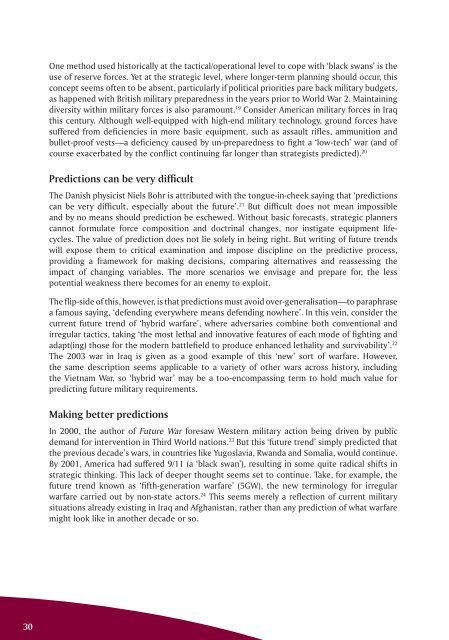ISSUE 183 : Nov/Dec - 2010 - Australian Defence Force Journal
ISSUE 183 : Nov/Dec - 2010 - Australian Defence Force Journal
ISSUE 183 : Nov/Dec - 2010 - Australian Defence Force Journal
Create successful ePaper yourself
Turn your PDF publications into a flip-book with our unique Google optimized e-Paper software.
One method used historically at the tactical/operational level to cope with ‘black swans’ is theuse of reserve forces. Yet at the strategic level, where longer-term planning should occur, thisconcept seems often to be absent, particularly if political priorities pare back military budgets,as happened with British military preparedness in the years prior to World War 2. Maintainingdiversity within military forces is also paramount. 19 Consider American military forces in Iraqthis century. Although well-equipped with high-end military technology, ground forces havesuffered from deficiencies in more basic equipment, such as assault rifles, ammunition andbullet-proof vests—a deficiency caused by un-preparedness to fight a ‘low-tech’ war (and ofcourse exacerbated by the conflict continuing far longer than strategists predicted). 20Predictions can be very difficultThe Danish physicist Niels Bohr is attributed with the tongue-in-cheek saying that ‘predictionscan be very difficult, especially about the future’. 21 But difficult does not mean impossibleand by no means should prediction be eschewed. Without basic forecasts, strategic plannerscannot formulate force composition and doctrinal changes, nor instigate equipment lifecycles.The value of prediction does not lie solely in being right. But writing of future trendswill expose them to critical examination and impose discipline on the predictive process,providing a framework for making decisions, comparing alternatives and reassessing theimpact of changing variables. The more scenarios we envisage and prepare for, the lesspotential weakness there becomes for an enemy to exploit.The flip-side of this, however, is that predictions must avoid over-generalisation—to paraphrasea famous saying, ‘defending everywhere means defending nowhere’. In this vein, consider thecurrent future trend of ‘hybrid warfare’, where adversaries combine both conventional andirregular tactics, taking ‘the most lethal and innovative features of each mode of fighting andadapt(ing) those for the modern battlefield to produce enhanced lethality and survivability’. 22The 2003 war in Iraq is given as a good example of this ‘new’ sort of warfare. However,the same description seems applicable to a variety of other wars across history, includingthe Vietnam War, so ‘hybrid war’ may be a too-encompassing term to hold much value forpredicting future military requirements.Making better predictionsIn 2000, the author of Future War foresaw Western military action being driven by publicdemand for intervention in Third World nations. 23 But this ‘future trend’ simply predicted thatthe previous decade’s wars, in countries like Yugoslavia, Rwanda and Somalia, would continue.By 2001, America had suffered 9/11 (a ‘black swan’), resulting in some quite radical shifts instrategic thinking. This lack of deeper thought seems set to continue. Take, for example, thefuture trend known as ‘fifth-generation warfare’ (5GW), the new terminology for irregularwarfare carried out by non-state actors. 24 This seems merely a reflection of current militarysituations already existing in Iraq and Afghanistan, rather than any prediction of what warfaremight look like in another decade or so.30
















